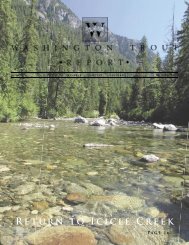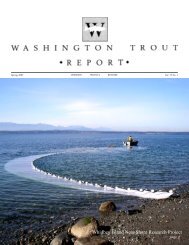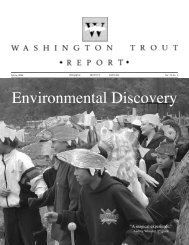Seafood Watch
Pacific Salmon - Wild Fish Conservancy
Pacific Salmon - Wild Fish Conservancy
- No tags were found...
You also want an ePaper? Increase the reach of your titles
YUMPU automatically turns print PDFs into web optimized ePapers that Google loves.
<strong>Seafood</strong> <strong>Watch</strong>® Wild Pacific Salmon Report October 8, 2010<br />
Figure 1.7. North American pink salmon range (Brownell 1999). 12<br />
Synthesis<br />
Salmon have relatively resilient life-history traits, including short life spans and high fecundity.<br />
These traits would typically result in a very low estimate of inherent vulnerability. However,<br />
salmon’s resilience belies a significant vulnerability based on their dependence on freshwater<br />
environments. Freshwater spawning habitats throughout the contiguous U.S. have been severely<br />
degraded by a large number of factors including the presence of dams, habitat alteration,<br />
introduced species, and pollution. In many cases, these losses have crippled the capacity of<br />
salmon runs to sustain even moderate fishing pressure. When these losses are combined with a<br />
limited range (river-specific ESUs) and a mixed-stock fishery, the vulnerability of salmon stocks<br />
to fishing in Oregon (north of Cape Falcon) and Washington must be considered moderate. In<br />
contrast, the relatively pristine rivers and streams of Alaska have allowed stocks there to remain<br />
resilient to heavy fishing pressure.<br />
12 Northern and western Alaskan drainages were not mapped by Brownell (1999), but presumably would be ranked<br />
as low or no risk.<br />
35






